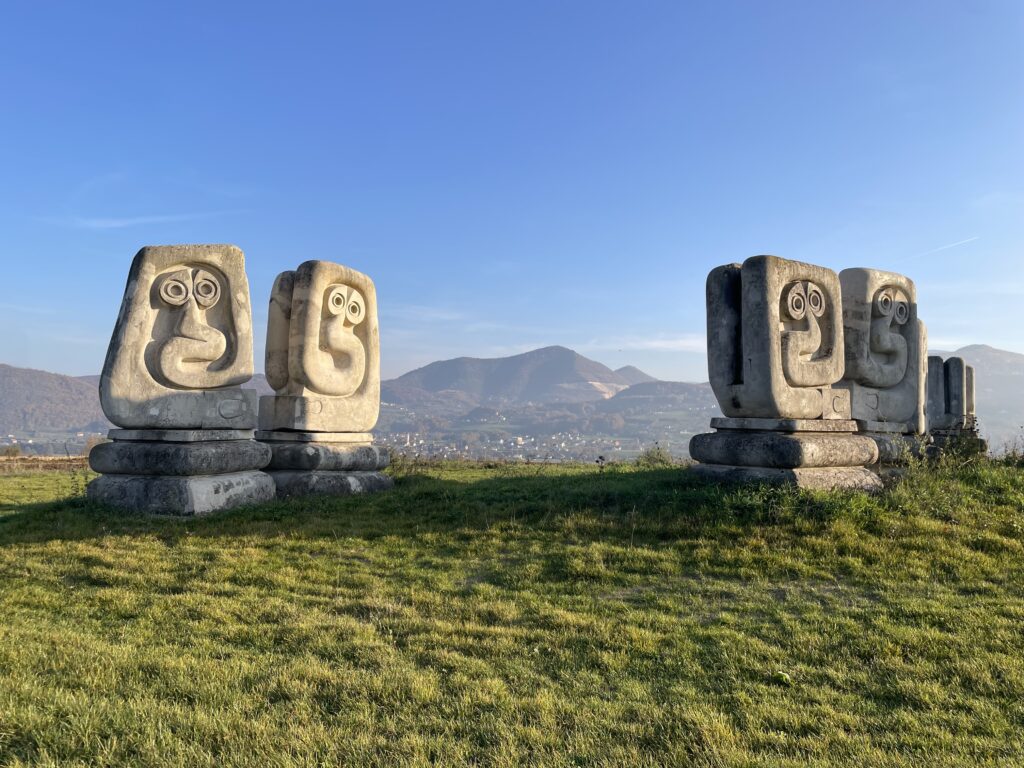Local Date
4 November 2024Local Time
10:44Location
Roadside near RaðiciCountry or Territory
Bosnia and HerzegovinaContributor
Sasha EngelmannSatellite
NOAA-18Radio Callsign
Archive ID
Coordinates
Turning off a narrow street, we climb a dirt road into hills of farmland. The smell of manure permeates the car as we pass farm equipment and local men that wave kindly at us. I think I hear one of them call out but he doesn’t follow us. The road winds steeply onward and turns against the edge of recently turned fields. Next to two stacks of hay, sandwiched between two different fields, both steaming with manure and dust, we can see curved shapes of stone. At the base of the hill, a plaque in an odd mix of Latin and Cyrillic letters, lines running at odd angles, seems like a warning, but we climb the hill anyway. We are completely alone except for two men driving tractors. There, on the hilltop, is a kind of assembly, a collection of surreal stone figures around two metres tall, arranged at odd angles to each other, resting on stone plinths. Like serpents with eyes or faces in contorted shapes the figures peer wildly and hauntingly into the distance. I notice there are rotting cobs of corn scattered on the grass in places, and I wonder if there are any offerings to these creatures. The site is Nekropola žrtvama fašizma (Necropolis for the Victims of Fascism) or Spomenik na Smrika (Monument on Smrike) designed by Bogdan Bogdanović and it is both monument and underground crypt. This is the site of a great massacre of around 700 Serbian civilians and communists by Ustaše forces during WWII. Of the monument, Bogdanović apparently said: “It is a story of mythical creatures: the ambisbaena is a two-headed serpent that goes by day in one direction and by night in another. It symbolizes the end of time." To me, though, the figures are less serpent-like and more like currents or energies.
Leaving Smrike by car, it is not long before we enter a valley shrouded in haze, and it only increases in density as we approach Sarajevo. We notice white smoke plumes pouring out of peoples’ chimneys and large currents of either steam or particulate flooding from thermo electric plants. I remember reading how a combination of local fuel burning in winter and heavy industry is creating an air pollution crisis in this part of Bosnia. The five o’ clock prayer echoes from minarets as the air thickens, spectral timing as voices mingle and seem to repeat across the landscape, and materialise the feeling that the air is a carrier of many things in these valleys, of faith and ghosts and microscopic toxicity.
I think about the double headed serpent invoked by Bogdanović and I wonder about the ‘end of time’. T and I both peer hard at the sky, wondering if we are seeing the sickle moon or a strange small arc in the sky. When the air is so thick and unbreathable, do we see and feel time passing more slowly, finding our circadian rhythms numbed, or do we see and feel what lies underground?




